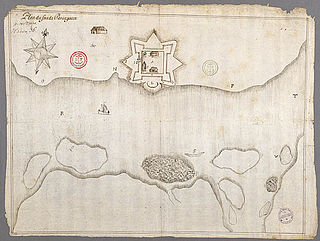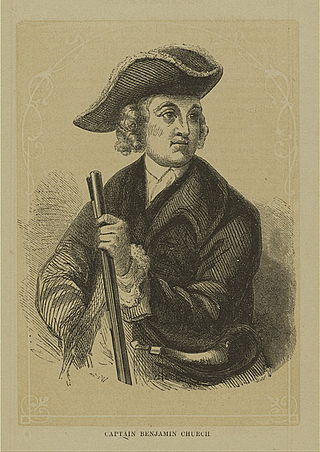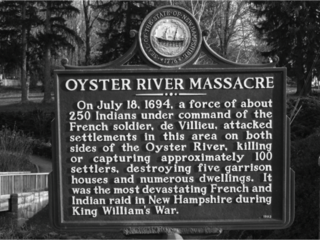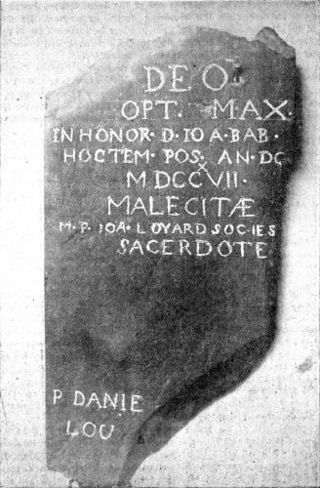
John Gyles (c.1680 at Pemaquid, Maine —1755 at Roxbury, Boston) was an interpreter and soldier, most known for his account of his experiences with the Maliseet tribes at their headquarters at Meductic, on the Saint John River. [1]

John Gyles (c.1680 at Pemaquid, Maine —1755 at Roxbury, Boston) was an interpreter and soldier, most known for his account of his experiences with the Maliseet tribes at their headquarters at Meductic, on the Saint John River. [1]
During King William's War, in 1689, when he was nine years of age, he was living with his family at Fort Charles. On 2 August, while labouring with his father Thomas near the new fort, he was taken prisoner by Maliseets in the Siege of Pemaquid (1689). His father was killed, one brother James was taken by the Penobscot, and only one brother escaped. John was conveyed up the Penobscot River, across portages to the Chiputneticook Lakes, and on to the main Maliseet village Meductic.

For six years, Gyles was a slave to the Maliseets. He was forced to serve as drudge to one of the many small hunting parties that moved as far north as Gaspésie and endured harsh treatment.
His fortunes greatly improved in the summer of 1695 when he was sold to Louis D'Amours de Chauffours, who had a seigneury at Jemseg. John hunted and traded for D'Amours and worked in his store. In October 1696, the English came up the Saint John River to attack the capital of Acadia in the Siege of Fort Nashwaak (1696). D'Amours was in France at the time, but Gyles helped to save his master's house from destruction. He posted on the door a statement, written by D'Amours' wife, that English captives had been treated kindly there. After the Treaty of Ryswick, Gyles was delivered to the captain of an English vessel at the mouth of the Saint John and sailed for Boston, where he arrived on 19 June 1698.
Gyles' knowledge of and fluency in the Indian dialects of Acadia made him invaluable to the governing authorities of New England when war broke out again in 1701. During Queen Anne's War, he was with March in the Northeast Coast Campaign (1703). He served as an interpreter under many flags of truce, sailed with Major Benjamin Church in 1704, and fought with Colonel John March at the Siege of Port Royal (1707).
Most of his later life was given to military service and liaison with the Indians. In 1715 he helped construct Fort George at Brunswick; which was attacked in 1722. [3] He remained to command the fort throughout Father Rale's War, until 1725. He finished his military career as commander of the New England garrison on Fort St. George (Thomaston, Maine). [1]
He married his first wife, Ruth True, in 1703 and his second, Hannah Heath in 1722.
In 1736 Gyles published his memoirs of his adventures. [4] First printed in Boston in 1736, it was reprinted in 1853 and in 1875, and used as the basis for a modern adaptation of the memoirs by Stuart Trueman in 1966. [1]
Gyles Cove, north of Hillman in York County, New Brunswick was named for him. [5]
The memoirs are considered a precursor to the frontier romances of James Fenimore Cooper, William Gilmore Simms, and Robert Montgomery Bird. [6]
A play was produced about his life called John Gyles: an Indian Experience by Theatre New Brunswick's Young Company in 1978. [7]

Penobscot Indian Island Reservation is an Indian reservation for the Penobscot Tribe of Maine, a federally recognized tribe of the Penobscot in Penobscot County, Maine, United States, near Old Town. The population was 758 at the 2020 census. The reservation extends for many miles alongside 15 towns and two unorganized territories in a thin string along the Penobscot River, from its base at Indian Island, near Old Town and Milford, northward to the vicinity of East Millinocket, almost entirely in Penobscot County. A small, uninhabited part of the reservation used as a game preserve and hunting and gathering ground is in South Aroostook, Aroostook County, by which it passes along its way northward.

King William's War was the North American theater of the Nine Years' War (1688–1697), also known as the War of the Grand Alliance or the War of the League of Augsburg. It was the first of six colonial wars fought between New France and New England along with their respective Native allies before France ceded its remaining mainland territories in North America east of the Mississippi River in 1763.

Dummer's War (1722–1725) was a series of battles between the New England Colonies and the Wabanaki Confederacy, who were allied with New France. The eastern theater of the war was located primarily along the border between New England and Acadia in Maine, as well as in Nova Scotia; the western theater was located in northern Massachusetts and Vermont at the border between Canada and New England. During this time, Maine and Vermont were part of Massachusetts.

The Battle of Port Royal occurred at Port Royal, the capital of Acadia, during King William's War. A large force of New England provincial militia arrived before Port Royal. The Governor of Acadia Louis-Alexandre des Friches de Menneval had only 70 soldiers; the unfinished enceinte remained open and its 18 cannon had not been brought into firing positions; 42 young men of Port-Royal were absent. Any resistance therefore appeared useless. Meneval surrendered without resistance not long after the New Englanders arrived. The New Englanders, led by Sir William Phips, after alleging Acadian violations of the terms of surrender, plundered the town and the fort.

Fort Pentagouët was a French fort established in present-day Castine, Maine, which was the capital of Acadia (1670–1674). It is the oldest permanent settlement in New England.
Madockawando was a sachem of the Penobscot, an adopted son of Assaminasqua, whom he succeeded. He led the Penobscot on the side of the French against the English during King William's War.

Fort William Henry is located in the village of New Harbor in the town of Bristol, Maine. The fort was, in its time, the largest in New England. The fort was originally built in 1692 but destroyed four years later by New France in the Siege of Pemaquid (1696). A reconstruction was built in 1908. The fort was added to the National Register of Historic Places on December 1, 1969. Fort William Henry is now operated as a museum about the fort's history.

The Raid on Chignecto occurred during King William's War when New England forces from Boston attacked the Isthmus of Chignecto, Acadia in present-day Nova Scotia. The raid was in retaliation for the French and Indian Siege of Pemaquid (1696) at present day Bristol, Maine. In the English Province of Massachusetts Bay. Colonel Benjamin Church was the leader of the New England force of 400 men. The raid lasted nine days, between September 20–29, 1696, and formed part of a larger expedition by Church against a number of other Acadian communities.

The siege of Pemaquid occurred during King William's War when French and Native forces from New France attacked the English settlement at Pemaquid, a community on the border with Acadia. The siege was led by Pierre Le Moyne d'Iberville and Baron de St Castin between August 14–15, 1696. Commander of Fort William Henry, Captain Pasco Chubb, surrendered the fort. Iberville killed three of the soldiers and sent the other 92 back to Boston.

The Naval battle off St. John took place on July 14, 1696, between France and England toward the end of King William's War in the Bay of Fundy off present-day Saint John, New Brunswick. The English ships were sent from Boston to interrupt the supplies being taken by French officer Pierre Le Moyne d'Iberville from Quebec to the capital of Acadia, Fort Nashwaak on the Saint John River. The French ships of war Envieux and Profond captured the English frigate Newport, while the English frigate Sorlings and a provincial tender escaped.

The Raid on Oyster River happened during King William's War, on July 18, 1694, at present-day Durham, New Hampshire.

The Battle of Falmouth involved Joseph-François Hertel de la Fresnière and Baron de St Castin leading troops as well as the Wabanaki Confederacy in New Brunswick to capture and destroy Fort Loyal and the English settlement on the Falmouth neck, then part of the Massachusetts Bay Colony. The commander of the fort was Captain Sylvanus Davis. After two days of siege, the settlement's fort, called Fort Loyal, surrendered. The community's buildings were burned, including the wooden stockade fort, and its people were either killed or taken prisoner. The fall of Fort Loyal (Casco) led to the near depopulation of Europeans in Maine. Native forces were then able to attack the New Hampshire frontier without reprisal.

The siege of Pemaquid was a successful attack by a large band of Abenaki Indians on the English fort at Pemaquid, Fort Charles, then the easternmost outpost of colonial Massachusetts. The French-Abenaki attack was led by Jean-Vincent d'Abbadie de Saint-Castin and Father Louis-Pierre Thury and Chief Moxus. The fall of Pemaquid was a significant setback to the English. It pushed the frontier back to Casco (Falmouth), Maine.

The siege of Fort Nashwaak occurred during King William's War when New England forces from Boston attacked the capital of Acadia, Fort Nashwaak, at present-day Fredericton, New Brunswick. The siege was in retaliation for the French and Indian Siege of Pemaquid (1696) at present day Bristol, Maine. In the English Province of Massachusetts Bay. Colonel John Hathorne and Major Benjamin Church were the leaders of the New England force of 400 men. The siege lasted two days, between October 18–20, 1696, and formed part of a larger expedition by Church against a number of other Acadian communities.

Meductic Indian Village / Fort Meductic was a Maliseet settlement until the mid-eighteenth century. It was located near the confluence of the Eel River and Saint John River in New Brunswick, four miles upriver from present-day Lakeland Ridges. The fortified village of Meductic was the principal settlement of the Maliseet First Nation from before the 17th century until the middle of the 18th, and it was an important fur trading centre..

The Northeast Coast campaign (1745) occurred during King George's War from 19 July until 5 September 1745. Three weeks after the British Siege of Louisbourg (1745), the Wabanaki Confederacy of Acadia retaliated by attacking New England settlements along the coast of present-day Maine below the Kennebec River, the former border of Acadia. They attacked English settlements on the coast of present-day Maine between Berwick and St. Georges, within two months there were 11 raids - every town on the frontier had been attacked. Casco was the principal settlement.
William Pote was a British surveyor and ship captain who wrote one of the few captivity narratives from Acadia/Nova Scotia when he was captured by the Wabanaki Confederacy during King George's War.

The Maliseet militia was made up of warriors from the Maliseet of northeastern North America. Along with the Wabanaki Confederacy, the French and Acadian militia, the Maliseet fought the British through six wars over a period of 75 years. They also mobilized against the British in the American Revolution. After confederation, Maliseet warriors eventually joined Canada's war efforts in World War I and World War II.

The Northeast Coast campaign of 1747 was conducted by the Wabanaki Confederacy of Acadia against the New England settlements along the coast of present-day Maine below the Kennebec River, the former border of Acadia. It took place from July until September 1747, and formed part of King George's War. The Wabanaki carried out 11 raids on English settlements on the coast between Berwick and St. Georges, with every town on the frontier being attacked. Casco was the principal settlement.
Simon-Gérard de La Place was a 17th-century French priest and missionary who served in Acadia, the French province in what is modern north-eastern Canada. He participated in King William's War against English-led forces in Acadia.